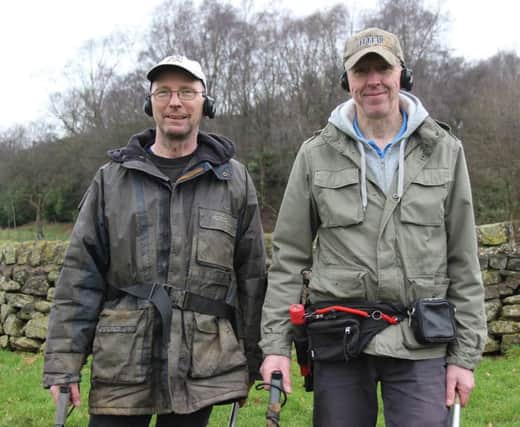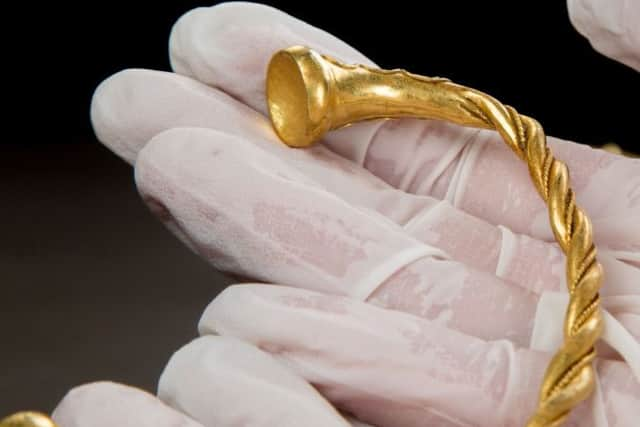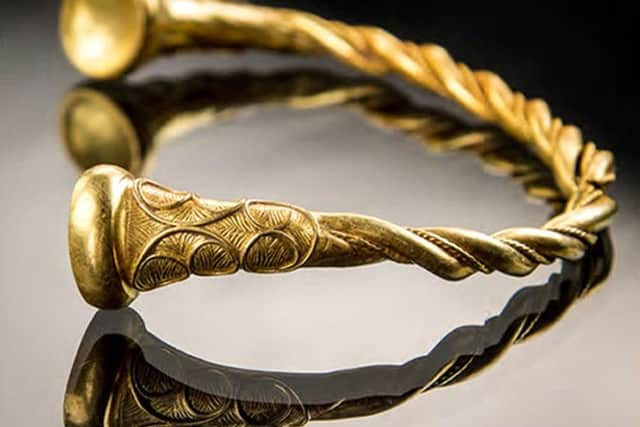These will be worth a bob or two says coroner, as treasure hunters unearth Iron Age rings in a cow field


Mark Hambleton and Joe Kania, lifelong friends with a passion for metal detectors, said they could not believe their eyes when, two months ago in the middle of a cow field in the Midlands, their sensors picked up four near-solid-gold, 18-carat rings.
The three necklaces and a bracelet had lain undiscovered for 2,500 years on a hillside in Staffordshire, and today the local community leapt into action to try to keep them there.
Advertisement
Hide AdAdvertisement
Hide AdA formal valuation will now take place but a fund-raising campaign is expected to be launched within weeks, aimed at securing the jewellery for permanent public display.


At a formal treasure inquest today, senior coroner Ian Smith said it would be “highly desirable” for the unique find to remain in the county.
After 60-year-old Mr Kania uncovered one of the bands, they then found three others concealed six inches below ground and a metre apart.
One of the rings was broken, probably by ploughing, and its other half was only discovered when the pair returned to the spot of the first dig last Sunday.
Advertisement
Hide AdAdvertisement
Hide AdStaffordshire is gaining a reputation as a hiding place for some of the country’s greatest historical treasures, with the latest discovery following 2009’s Anglo-Saxon Staffordshire Hoard find, worth £3.285 million.


This new find near Leek is about 45 miles north of Hammerwich, near Lichfield - the site of the vast 3,900-piece Saxon Hoard, which is perhaps the most famous discovery made by a metal detectorist.
It is not known why the Leekfrith Iron Age Torcs were buried, but it could have been for safekeeping, an offering to the gods, or as an act of remembrance.
The decoration on the sole bracelet has excited experts because it is thought to be some of the earliest Celtic British art.
Advertisement
Hide AdAdvertisement
Hide AdMr Hambleton had searched the same field once before, about 20 years ago, but without success.


After scouring the cold ground on the morning of December 11 last year, both men were ready to call it a day when suddenly Mr Kania got a signal.
Pulling out the first torc on his hands and knees, Mr Kania said his initial thought was “bloody hell, I’ve seen this in a treasure-hunting magazine”.
Mr Hambleton, 59, said: “I’d had enough, I’d taken my detector off and packed up.”
Advertisement
Hide AdAdvertisement
Hide AdHe added: “He (Joe) shouted to me ‘I think I’ve found something quite significant’.


“He pulled this big torc out of his pocket, and dangled it in front of me.
“When I’d got some air back into my lungs, my head had cleared and my legs had stopped wobbling, I said ‘do you realise what you’ve found there?’”
After digging up the rest of the gold, Mr Hambleton admitted he had had a sleepless night with the haul next to his bed.
Advertisement
Hide AdAdvertisement
Hide AdHe handed the gold over to experts at Birmingham Museums the next day, with archaeologists from Staffordshire County Council and Stoke-on-Trent City Council brought in to investigate the finds site.
The men are now planning to split the find 50/50 with landowner Stuart Heath.
Mr Heath said it was “fate” the gold had been found by the men, because it had repaid the kindness Mr Hambleton’s late father had shown him as a boy.
• What is treasure?
All gold and silver objects that are more than 300 years old, and prehistoric base metals (including copper, bronze and lead) are defined as treasure under the Treasure Act 1996, which covers England, Wales and Northern Ireland. People are obliged to report treasure finds in England and Wales but do not have to record archaeological non-treasure items. In Scotland all items - both treasure and non-treasure - must be reported by law.
• How much treasure is discovered each year?
Advertisement
Hide AdAdvertisement
Hide AdAround 80,000 finds are reported to the Portable Antiquities Scheme (which covers England and Wales) annually, and of these approximately 1,000 are confirmed as treasure, the British Museum said. Treasure Registrar Ian Richardson said reporting has been increasing, with more than 1,100 treasure finds recorded in 2016. He said: “We think more people are aware of their legal obligation to report these finds.”
• Who should you go to if you think you have discovered something significant?
The first port of call for people in England and Wales is someone called a Finds Liaison Officer, 38 of whom are stationed across the country. They can help people to establish whether their discovery really could be treasure. If that is deemed likely to be the case, the find must be reported to the coroner within 14 days of the discovery or 14 days from the point at which you suspected it might be treasure. Not reporting a find you think could be treasure can result in a three-month jail term and £5,000 fine.
• What happens after something is declared to be treasure?
Depending on how rare or interesting the treasure is considered to be, it can go to a museum. In some cases the finds can be acquired by larger organisations such as the British Museum, but in many cases they will be taken in and displayed by local museums. Around half of the discoveries are returned to the finder, Mr Richardson said. “Some museums may not want them because the objects are in such a poor condition or they already have something similar or the same,” he said. “But we would encourage people to take items to their local museums just in case they are of interest.”